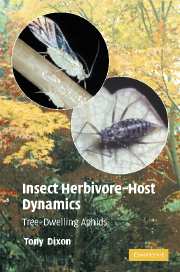Book contents
- Frontmatter
- Contents
- Preface
- 1 Introduction
- 2 Tree-dwelling aphids
- 3 Trees as a habitat: relations of aphids to trees
- 4 Trees as a habitat: relations of aphids to their natural enemies
- 5 Carrying capacity of trees
- 6 Aphid abundance
- 7 Population dynamics
- 8 Risky dispersal
- 9 Seasonal sex allocation
- 10 Aphids and tree fitness
- 11 Rarity, conservation and global warming
- Epilogue
- References
- Species index
- Subject index
5 - Carrying capacity of trees
Published online by Cambridge University Press: 08 August 2009
- Frontmatter
- Contents
- Preface
- 1 Introduction
- 2 Tree-dwelling aphids
- 3 Trees as a habitat: relations of aphids to trees
- 4 Trees as a habitat: relations of aphids to their natural enemies
- 5 Carrying capacity of trees
- 6 Aphid abundance
- 7 Population dynamics
- 8 Risky dispersal
- 9 Seasonal sex allocation
- 10 Aphids and tree fitness
- 11 Rarity, conservation and global warming
- Epilogue
- References
- Species index
- Subject index
Summary
The sigmoidal shape of the growth of human populations was first represented mathematically by Verhulst (1838) and subsequently independently by Pearl and Reed (1920). This led to attempts to use laboratory populations to verify what came to be referred to as the logistic model. Although this is not the only mathematical model that fits population growth curves it has the great merit of being simple and biologically realistic. It neatly encapsulates the concept that populations increase until the demands made on the resources preclude further growth and the population is then at its saturation level, a value determined by the carrying capacity of the environment (Varley et al., 1973; Begon & Mortimor, 1981; Berryman, 1981; Renshaw, 1991). Saturation level/point was first used by Lotka (1924), and carrying capacity first coined by Errington (1934) and Errington and Hamerstrom (1936). Initially carrying capacity was used to specify the maximum number of bobwhite quail an environment could sustain. Later Errington (1946) used it when referring to populations of other vertebrates, especially birds and rodents, which showed some form of territorial behaviour. Carrying capacity as a concept proved very attractive and was quickly equated with K in the logistic model and replaced saturation point and level. In 1988 carrying capacity was voted the seventeenth most popular ecological concept by members of the British Ecological Society (Cherrett, 1988).
- Type
- Chapter
- Information
- Insect Herbivore-Host DynamicsTree-Dwelling Aphids, pp. 54 - 63Publisher: Cambridge University PressPrint publication year: 2005



